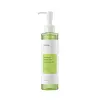What's inside
What's inside
 Key Ingredients
Key Ingredients

 Benefits
Benefits

 Concerns
Concerns

 Ingredients Side-by-side
Ingredients Side-by-side

Helianthus Annuus Seed Oil
EmollientGlycine Soja Oil
EmollientSorbeth-30 Tetraoleate
EmulsifyingCentella Asiatica Oil
AntimicrobialCupressus Sempervirens Leaf Oil
MaskingMoringa Oleifera Seed Oil
EmollientSimmondsia Chinensis Seed Oil
EmollientCarapa Guaianensis Seed Oil
Skin ConditioningMelia Azadirachta Leaf Extract
Skin ConditioningMelia Azadirachta Flower Extract
Skin ConditioningCoccinia Indica Fruit Extract
Skin ConditioningSolanum Melongena Fruit Extract
Skin ConditioningCurcuma Longa Root Extract
MaskingOcimum Sanctum Leaf Extract
Skin ConditioningCorallina Officinalis Extract
Skin ConditioningSorbitan Sesquioleate
EmulsifyingAmber Powder
Squalane
EmollientHelianthus Annuus Seed Oil, Glycine Soja Oil, Sorbeth-30 Tetraoleate, Centella Asiatica Oil, Cupressus Sempervirens Leaf Oil, Moringa Oleifera Seed Oil, Simmondsia Chinensis Seed Oil, Carapa Guaianensis Seed Oil, Melia Azadirachta Leaf Extract, Melia Azadirachta Flower Extract, Coccinia Indica Fruit Extract, Solanum Melongena Fruit Extract, Curcuma Longa Root Extract, Ocimum Sanctum Leaf Extract, Corallina Officinalis Extract, Sorbitan Sesquioleate, Amber Powder, Squalane
Caprylic/Capric Triglyceride
MaskingCetyl Ethylhexanoate
EmollientIsononyl Isononanoate
EmollientPEG-7 Glyceryl Cocoate
EmulsifyingIsopropyl Myristate
EmollientSimmondsia Chinensis Seed Oil
EmollientGlycine Soja Oil
EmollientSesamum Indicum Seed Oil
EmollientRibes Nigrum Seed Oil
EmollientTocopheryl Acetate
AntioxidantPEG-20 Glyceryl Triisostearate
EmollientPolysorbate 20
EmulsifyingParfum
MaskingButyrospermum Parkii Butter
Skin ConditioningCarapa Guaianensis Seed Oil
Skin ConditioningVaccinium Macrocarpon Seed Oil
Skin ConditioningCaprylic/Capric Triglyceride, Cetyl Ethylhexanoate, Isononyl Isononanoate, PEG-7 Glyceryl Cocoate, Isopropyl Myristate, Simmondsia Chinensis Seed Oil, Glycine Soja Oil, Sesamum Indicum Seed Oil, Ribes Nigrum Seed Oil, Tocopheryl Acetate, PEG-20 Glyceryl Triisostearate, Polysorbate 20, Parfum, Butyrospermum Parkii Butter, Carapa Guaianensis Seed Oil, Vaccinium Macrocarpon Seed Oil
 Reviews
Reviews

Ingredients Explained
These ingredients are found in both products.
Ingredients higher up in an ingredient list are typically present in a larger amount.
Carapa Guaianensis Seed Oil is an oil and isn't fungal acne safe.
Glycine Soja Oil comes from the soybean. Glycine Soja is native to eastern Asia.
Soybean oil is an emollient. It is rich in antioxidants and fatty acids including palmitic, stearic, oleic, and linoleic acids.
As an emollient, the fatty acids in soybean oil helps keep your skin soft and hydrated. It does so by creating a film on top that traps moisture in.
Soybean oil is also rich in vitamin E, a potent antioxidant. Vitamin E is also anti-inflammatory and provides a soothing effect.
Studies show soy may help fade hyperpigmentation from UVB. It does so by disrupting the melanin process from UVB induced skin inflammation.
This ingredient may not be malassezia folliculitis, or fungal-acne, safe.
Soybeans are rich in proteins and are part of the legume family. Foods made with soybeans include tofu, soymilk, edamame, miso, and soy sauce.
Learn more about Glycine Soja OilThis oil comes from the seeds of the desert shrub called Jojoba. It is more commonly known as jojoba oil, a non-comedogenic oil.
Jojoba oil does not contain fragrance and has many fatty-acids, making it a great soothing ingredient.
It also contains Vitamin E, a great moisturizing ingredient. Vitamin E is also an antioxidant and protects your skin against oxidative damage.
This ingredient humectant properties, meaning it helps draw moisture from the air. This helps keep your skin hydrated.
While jojoba has antibacterial properties, it is only able to kill some strains of bacteria.
Studies also show it helps in wound healing. In fact, Indigenous cultures have used jojoba as a moisturizer and to help treat burns for centuries.
Fun fact: Jojoba oil similar to natural human skin sebum, so it has a great effect on dry skin. It is also promising with helping to regulate sebum production.
Due to its fatty acid content, Jojoba oil may not be fungal acne safe. We recommend speaking with a professional if you have any concerns.
Learn more about Simmondsia Chinensis Seed Oil